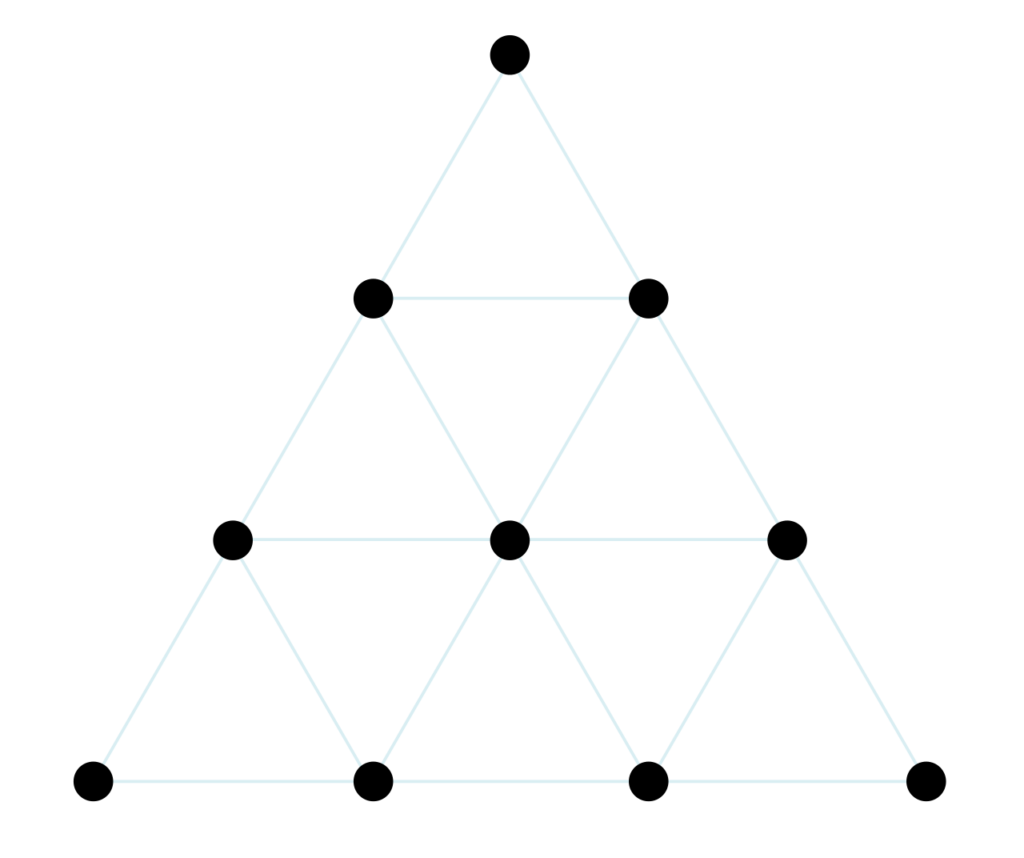
Sacred geometry is a concept developed in ancient times grounded on the idea that the world is created based on a consistent geometrical pattern. This “mysterious” geometry can be found in ancient Greek temples all over Greece. The concept ascribes symbolic and sacred meanings to certain geometric shapes and geometric proportions associated with the belief of an orderly universe.
Sacred geometry triangles ‘Connecting’ ancient Greek temples
During ancient Greece, this concept was manifested in two triangles formed by three sacred places each. One is formed by the ancient Greek Temple of Poseidon at Cape Sounio, the Temple of Aphaia Athena on Aegina, and the Temple of Hephaestus in Thissio of Athens. The second triangle is comprised of the Temple of Apollo at Delphi, the Parthenon in Athens, and the Temple of Aphaia on Aegina.
In 1938, World Renowned architect Doxiades discovered that the monuments and altars were not randomly placed or constructed, but there was a pattern. In 1967, French researcher Jean Richer, wrote the book Sacred Geography of the Ancient Greeks, in which he analyzes those connections.
In his book, Richer claims that if linear lines were drawn from altar to altar, they would mirror constellations along with zodiac cycles. In fact, Richer argues that many of the patron animals of these ancient Greek cities were correlated to the locations of constellations that often included mythological attributions.
Furthermore, in the 1950s, an unknown scientist stated that the distances between the three temples of Sounion, Aphaia, and the Parthenon created a perfect isosceles triangle.
If a circle was constructed with the Parthenon as the center and a radius line to Thision, it would be found that the circumference of this circle passes by three main points. The orator’s step of Pnyx, the monument of Filopappou, and the temple of Olympian Zeus. Even more interestingly, the radius of this circle is equal to 2,058 feet, or three hundred times the golden ratio. Another interesting fact is that the center of the temple of Olympian Zeus lies equidistant with Hephaestion and the step of the rhetors at Pnyx.
Researches can also find the five-edged star of the Pythagoreans. The star falls with these five locations, Thebes, Cromion, Aphaia, Stiris, and Amfiaron. Thus, this points to the geometric harmony of these locations as well as their purposeful arrangement.
Sacred triangle of Greek temples.
Parthenon (Athens), Temple of Poseidon (Sounion), Temple of Aphaia (Aegina) form a perfect isosceles triangle, all facing east.
Geometric distances factored in building temples#Greece #Greek #archaeology #ancientgreece #geometry #Athens #Museum pic.twitter.com/ja6GBvAc5Q— SpartiatisΣπαρτιατης (@KSpartiatis) April 7, 2019
According to Greek historian Herodotus (c. 484-425 BC), geometry was established as a science by the ancient Egyptians. There is written evidence of this in Egypt. The ancient Mesopotamians are also known to have practiced geometry, as did early Chinese and Indians. The Greek name for this branch of mathematics is derived from the words ‘geo’ (Earth) and ‘metron’ (measure), literally meaning “measuring the world.”
The ancient Greek mathematician Euclid is considered the father of geometry. His treatise on geometry, The Elements, is one of the most influential works in the history of mathematics. Euclid’s work is a prime example of the rational and academic approach to the study of geometry. Other geometers and thinkers, however, saw symbolic and sacred meanings in geometry, and, therefore, their field of study may be referred to as sacred geometry.
A group of these thinkers were the Pythagoreans, whose school of philosophy was founded by Pythagoras of Samos.
Pythagoreans and the tetractys
The first symbol in sacred geometry originates from the Pythagoreans and is called the tetractys, or the tetractys of the decad (tetractys meaning “four” and decad meaning “ten”). This symbol consists of ten dots arranged in four rows, thus forming an equilateral triangle. The tetractys is full of symbolic meaning. For example, each row of dots is said to contain a hidden meaning.
The first row, which has a single dot, represents the active principle, or divine power behind all creation. The second represents the passive principle, or matter, while the third refers to the world proceeding from the union of the active and passive principles. The fourth is associated to the four liberal arts and sciences of which the world is composed.

The Pythagoreans were not the only ancient Greeks who delved into sacred geometry. Overall, it was a philosophical idea that the world shared a symbolic pattern of shapes that ceaselessly manifest in nature, including plants, animals, the human body, and generally across the entire universe.
Plato and his academy studied geometry mainly for these philosophical purposes, and mathematics itself was to provide a map of the human psyche. At the entrance to Plato’s Academy, there is an inscription meaning “let no one ignorant of geometry come under my roof” (Greek: “Mηδείς ἀγεωμέτρητος εἰσίτω μου τὴν στέγην”).
This study of the philosophical value inherent in the basics of geometry was considered sacred and became a universal language mainly among philosophers.
The circle in sacred geometry
Apart from the triangle, found in the sacred geometry of ancient Greek temples, many other shapes have been imbued with symbolic meaning. Greeks perceived the circle as a symbol of unity, oneness, and indivisibility. The circle is almost universally employed as a symbol for the Sun. It may be repeated in order to create new symbols, such as circles within larger circles or intertwining ones.
Aristotle wrote in Physics that the circle is “the perfect, first, most beautiful form.” In both geometry and sacred geometry, the circle is considered to be the most essential shape, as it symbolizes unity in both the two and three dimensional. Earth is a sphere as are the other planets, moons, stars, galaxies, and most fundamental forms of life such as atoms, molecules, seeds, and eggs.
The circle also represents the cycles of life and is therefore connected to growth and movement. Cyclical movement patterns are essential to life and can be observed between all the planets circling around the sun, the moons revolving around the planets, and the planets spinning on their axis, leading to further cycles of days, months, and years.
Searching for the Golden Ratio
The Golden Ratio is crucial to sacred geometry. It is known by many other names, including phi (the Greek Φ), the divine proportion, and the golden mean. Ιn Euclid’s Elements, you find one of the first recorded definitions of this golden ratio: “A straight line is said to have been cut into extreme and mean ratio when, as the whole line is to the greater segment, so is the greater to the lesser.”
In simpler terms, the Golden Ratio refers to a perfectly symmetrical relationship between two proportions by which the relationship between the larger and smaller parts is the same as that between the whole and the larger parts.
The mathematics of the Golden Ratio proportion is generated by the formula (√5+1/2) (or 1:1.618). Τhe ancient Greeks found that the Golden Ratio provided “the most aesthetically pleasing proportion of sides of a rectangle.” They are alleged to have applied it in their architecture. This ratio is renowned for producing some of the most aesthetic shapes.

Platonic solids and sacred geometry
According to the great Athenian philosopher Plato in his dialogue Timaeus, the Earth is composed of four basic elements—fire, air, water, and earth.
The Platonic solids are five three-dimensional shapes essential to sacred geometry. These are the tetrahedron, hexahedron (or cube), octahedron, dodecahedron, and icosahedron, which have four, six, eight, twelve, and twenty sides, respectively.
Plato associated his solids with the four basic elements. The tetrahedron represented fire, due to its sharp points and edge, whereas the hexahedron was linked with earth, due to its four-square regularity. The octahedron and icosahedron, both of which are made up of triangles, represent air and water, respectively.
Lastly, the dodecahedron was assigned by Plato to the heavens, as its twelve pentagonal faces corresponded with the twelve constellations. Using these five solids, Plato created a theory of the universe. Plato’s theory was based on the symbolic properties of the five solids, and mathematicians were less interested in them.
However, his theory was revived during the sixteenth century by the German astronomer Johannes Kepler. Since then, the Platonic solids have made their way into sacred geometry and acquired additional symbolic value.
See all the latest news from Greece and the world at Greekreporter.com. Contact our newsroom to report an update or send your story, photos and videos. Follow GR on Google News and subscribe here to our daily email!



